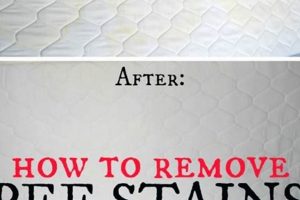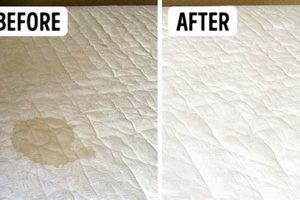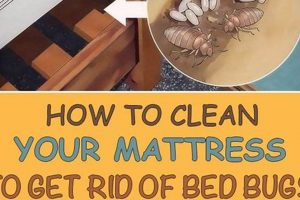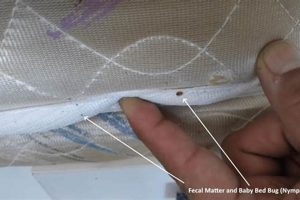The disposal of bulky items like mattresses and box springs presents a logistical challenge for many individuals and households. Options available for managing this process range from municipal services to private disposal companies and charitable donations. The selected method often depends on the item’s condition, local regulations, and the individual’s resources.
Proper disposal is important for environmental reasons, diverting these large items from landfills where they contribute to space constraints and potential environmental harm. Furthermore, responsible disposal or repurposing aligns with sustainable practices and can benefit communities through donation programs. Historically, unregulated dumping was common, but increasing awareness and stricter regulations are encouraging more responsible methods.
This article will explore various strategies for handling mattress and box spring disposal, detailing the steps involved in each method and providing information on cost considerations, potential environmental impacts, and available resources. Subsequent sections will address donation options, recycling facilities, and waste management services.
Tips for Mattress and Box Spring Disposal
The following tips provide guidance on appropriate and effective strategies for disposing of mattresses and box springs, ensuring environmental responsibility and adherence to local regulations.
Tip 1: Research Local Regulations: Prior to any disposal effort, investigate local municipality guidelines. Many jurisdictions have specific rules regarding bulky waste collection, including size restrictions, preparation requirements, and designated drop-off locations. Failure to comply may result in fines.
Tip 2: Explore Donation Options: If the mattress and box spring are in reasonably good condition free from significant stains, tears, or infestations consider donating them to a local charity or non-profit organization. Contact the organization beforehand to confirm acceptance policies and any prerequisites for donation.
Tip 3: Investigate Recycling Facilities: Mattress recycling is becoming increasingly common. Search for recycling facilities in the vicinity that accept mattresses and box springs. These facilities dismantle the items and repurpose the components, such as steel springs and foam, reducing landfill waste.
Tip 4: Utilize Municipal Waste Collection Services: Contact the local waste management department to inquire about bulky waste collection services. Many municipalities offer scheduled pick-up days for large items. Be prepared to adhere to specific preparation guidelines, such as wrapping the mattress in plastic to prevent the spread of pests or contamination.
Tip 5: Consider Professional Disposal Services: Several companies specialize in mattress removal and disposal. These services often offer convenient pick-up options, but they typically involve a fee. Obtain quotes from multiple providers to ensure competitive pricing.
Tip 6: Assess Condition Thoroughly: A careful inspection of the mattress and box spring is crucial. Look for signs of bed bugs, mold, or other contaminants. Items in unsanitary condition should be disposed of responsibly, potentially requiring special handling or professional assistance to avoid spreading infestations.
Tip 7: Document the Disposal: Keeping records of the disposal method, such as receipts from recycling facilities or confirmation from waste management services, can be helpful in case of any future inquiries or issues.
Following these tips ensures responsible management of mattress and box spring disposal, contributing to environmental sustainability and community well-being. Proper planning and adherence to regulations are essential for a smooth and ethical process.
The subsequent sections will delve deeper into specific methods of disposal, outlining detailed procedures and associated costs.
1. Donation Opportunities
Donation opportunities represent a viable method for responsibly managing the disposal of mattresses and box springs, provided specific conditions are met. The availability of these opportunities directly impacts the strategies employed for disposal, offering an alternative to landfill deposition or resource-intensive recycling processes. The acceptance of mattresses and box springs as donations hinges on their condition; generally, items must be free from significant stains, tears, or pest infestations to be considered suitable for redistribution. Organizations such as homeless shelters, disaster relief agencies, and furniture banks often accept these items, benefiting individuals and families in need.
The importance of donation as a component of the disposal process lies in its ability to extend the lifespan of usable goods, reducing environmental impact and supporting community initiatives. For example, a furniture bank might accept a gently used mattress set from a household upgrading to a new model, subsequently providing that set to a family transitioning out of homelessness. This not only addresses the immediate need for bedding but also reduces the demand for new mattress production, conserving resources and minimizing waste. However, the practical application of donation opportunities necessitates careful vetting of recipient organizations to ensure adherence to health and safety standards.
In summary, donation constitutes an ethically and environmentally sound option for mattress and box spring disposal when items meet specified quality criteria. The availability of donation programs varies geographically and requires proactive investigation by individuals seeking to responsibly manage their unwanted bedding. This approach diverts usable goods from landfills, supports vulnerable populations, and promotes a circular economy by extending product lifecycles. A significant challenge lies in ensuring donated items meet hygiene and safety standards, requiring thorough inspection and, potentially, professional cleaning before redistribution.
2. Recycling Availability
Recycling availability significantly influences the strategies employed for mattress and box spring disposal. The presence or absence of mattress recycling facilities directly impacts the environmental sustainability and economic feasibility of disposal methods. Locations with robust recycling infrastructure offer individuals and municipalities environmentally responsible alternatives to landfill disposal.
- Material Recovery and Repurposing
Mattress recycling involves the dismantling of mattresses and box springs into their constituent materials. Steel springs, foam, textiles, and wood components are separated and processed for reuse in various manufacturing applications. For instance, steel springs can be melted down and repurposed into new metal products, while foam can be shredded and used as carpet padding. This process reduces the demand for virgin materials and lowers the environmental impact associated with resource extraction and manufacturing.
- Reduction of Landfill Waste
Mattresses and box springs occupy substantial volume in landfills, contributing to space constraints and potential environmental hazards. Recycling diverts these bulky items from landfills, extending landfill lifespan and minimizing the risk of soil and water contamination. Moreover, the decomposition of mattress components in landfills can generate greenhouse gases, which contribute to climate change. Recycling mitigates these negative environmental effects.
- Geographic Variability and Accessibility
The availability of mattress recycling facilities varies significantly by geographic region. Urban areas and states with strong environmental regulations often have more developed recycling infrastructure compared to rural areas or regions with less stringent environmental policies. This geographic disparity affects the accessibility of recycling options for individuals seeking to dispose of mattresses and box springs responsibly. Consequently, individuals in areas with limited recycling availability may face higher disposal costs or be compelled to utilize less environmentally sound methods.
- Economic Considerations and Incentives
The economic viability of mattress recycling is influenced by factors such as material prices, labor costs, and transportation expenses. Government subsidies, extended producer responsibility (EPR) programs, and landfill disposal fees can incentivize mattress recycling by making it more economically competitive compared to landfilling. These economic incentives can encourage the development of recycling infrastructure and increase the adoption of mattress recycling practices by consumers and businesses.
In conclusion, the presence of accessible and economically viable recycling programs profoundly affects the methods available for mattress and box spring disposal. Recycling availability directly correlates with environmental sustainability, landfill diversion rates, and the overall cost of disposal. Enhanced recycling infrastructure and supportive economic policies are essential for promoting responsible mattress disposal practices and minimizing the environmental impact of discarded bedding materials.
3. Municipal services
Municipal services often play a critical role in facilitating mattress and box spring disposal for residents. These services, funded through local taxes and fees, offer various options that influence disposal methods and compliance rates.
- Curbside Collection Programs
Many municipalities operate scheduled curbside collection programs for bulky waste, including mattresses and box springs. Residents can place these items at the curb on designated collection days, often with specific preparation requirements such as wrapping in plastic to prevent pest infestation. The effectiveness of these programs hinges on communication, scheduling, and enforcement of regulations. Programs increase convenience, promoting responsible disposal and reducing illegal dumping.
- Drop-off Facilities and Transfer Stations
Municipalities often provide designated drop-off facilities or transfer stations where residents can dispose of bulky waste items, including mattresses and box springs. These facilities may be free for residents or charge a disposal fee. Accessibility, location, and hours of operation determine their utility. Transfer stations serve as collection points before waste is transported to landfills or recycling centers.
- Special Waste Disposal Events
Some municipalities organize periodic special waste disposal events to handle items not typically collected through regular waste services, such as mattresses, electronics, and hazardous materials. These events offer residents a convenient and cost-effective way to dispose of these items responsibly. Events often involve partnerships with recycling organizations or waste management companies.
- Enforcement and Regulations
Municipalities enforce regulations related to illegal dumping and proper waste disposal, which directly impacts mattress and box spring management. Regulations may specify requirements for wrapping mattresses, set limits on the number of items collected, or prohibit disposal in public areas. Enforcement mechanisms include fines, warnings, and public education campaigns.
The availability and effectiveness of municipal services are key determinants in how residents manage mattress and box spring disposal. Well-designed programs, coupled with effective enforcement and public awareness, promote responsible waste management practices and minimize environmental impacts. Municipal services must adapt to population growth, changing waste streams, and evolving environmental regulations to maintain their effectiveness in bulky waste management.
4. Private hauling costs
Private hauling costs represent a significant factor in the decision-making process for individuals seeking methods of mattress and box spring disposal. These costs vary considerably based on location, service provider, and the specific requirements of the disposal task. The expense associated with private hauling directly influences the choice of disposal method, potentially favoring more economical alternatives.
- Distance and Accessibility Fees
Hauling companies often base their pricing on the distance traveled to the pick-up location and the ease of access to the items being removed. Residences located farther from the hauler’s base of operations or those with difficult access (e.g., multiple flights of stairs) may incur higher fees. These factors directly impact the overall cost of disposal, potentially making other options more attractive.
- Volume and Item-Specific Charges
Private haulers typically charge based on the volume of items being removed. Mattresses and box springs, due to their size, often command a premium compared to smaller household items. Some haulers may impose specific charges for mattresses to account for handling and disposal challenges. This pricing structure necessitates comparing costs among different service providers to identify the most economical option.
- Disposal Fees and Environmental Compliance
A portion of the private hauling cost may include disposal fees charged by landfills or recycling facilities. Haulers operating in compliance with environmental regulations may also incur additional expenses related to proper disposal methods. These costs are often passed on to the customer, influencing the final price. Choosing haulers who demonstrate responsible disposal practices may involve higher initial expenses but aligns with sustainability goals.
- Service Level and Convenience Premiums
Some private hauling services offer enhanced service levels, such as same-day pick-up or inside removal. These convenience premiums increase the overall cost but may be justified by the time savings and reduced effort for the individual. Deciding whether to pay for premium services involves balancing cost considerations with personal convenience and logistical requirements.
In conclusion, private hauling costs play a pivotal role in determining how individuals manage the disposal of mattresses and box springs. These costs, influenced by distance, volume, disposal fees, and service level, must be carefully weighed against alternative disposal methods, such as municipal services or donation opportunities. The decision-making process requires comparing prices, assessing convenience, and considering environmental responsibility to arrive at the most suitable and cost-effective solution.
5. Environmental impact
The environmental impact of mattress and box spring disposal is significant, stemming from landfill waste, resource depletion, and potential pollution. The sheer volume of these discarded items contributes to landfill overcrowding, accelerating the need for new landfill development and its associated environmental consequences. Mattresses, primarily composed of materials like steel, foam, and textiles, require considerable resources for their initial production. Disposing of them improperly negates the potential for material recovery and reuse, perpetuating a cycle of resource extraction and waste generation.
Improper disposal practices exacerbate the environmental burden. Illegal dumping of mattresses can lead to soil and water contamination as materials degrade over time. The decomposition process releases greenhouse gases, contributing to climate change. Furthermore, abandoned mattresses can serve as breeding grounds for pests and pose public health risks. Conversely, responsible disposal methods, such as recycling and donation, mitigate these negative impacts. Recycling recovers valuable materials, reducing the need for virgin resource extraction and minimizing landfill waste. Donation extends the lifespan of usable mattresses, serving communities in need and reducing the demand for new production. Extended Producer Responsibility (EPR) programs hold manufacturers accountable for the end-of-life management of their products, incentivizing them to design more recyclable and durable mattresses.
Understanding the environmental impact is crucial for promoting sustainable disposal practices. Consumers, manufacturers, and policymakers all have a role to play in reducing the environmental footprint of mattress disposal. By supporting recycling initiatives, donating usable items, and advocating for EPR programs, stakeholders can collectively minimize the negative environmental consequences associated with discarded mattresses and box springs. The challenge lies in scaling up recycling infrastructure, raising public awareness about responsible disposal options, and implementing effective regulatory frameworks to ensure compliance and accountability.
6. Pest infestation risks
Pest infestation risks are a critical consideration in mattress and box spring disposal. The potential for harboring pests, particularly bed bugs, significantly complicates the disposal process and necessitates specific precautions to prevent further infestation.
- Bed Bug Transmission
Bed bugs are notorious for infesting mattresses and box springs, making these items a primary vector for their spread. Discarding an infested mattress without proper precautions can lead to the establishment of new infestations in homes, apartment buildings, or even public areas. The resilient nature of bed bugs, coupled with their ability to survive for extended periods without feeding, underscores the importance of careful handling during disposal.
- Legal and Ethical Obligations
Many jurisdictions have regulations regarding the disposal of infested mattresses to prevent the spread of pests. Landlords, property managers, and individuals disposing of infested items may have legal obligations to ensure proper treatment and containment. Ethically, failing to address an infestation before disposal can expose others to potential health risks and economic burdens associated with pest control.
- Identification and Treatment Protocols
Prior to disposal, a thorough inspection of the mattress and box spring is essential to identify any signs of pest infestation, such as live bed bugs, cast skins, or fecal stains. If an infestation is detected, professional pest control services should be consulted to implement appropriate treatment protocols. These may include heat treatment, chemical applications, or encasement to eliminate or contain the pests before disposal.
- Safe Disposal Practices
To minimize the risk of pest transmission during disposal, infested mattresses and box springs should be wrapped in thick plastic sheeting and sealed securely. This prevents bed bugs from escaping during transport and reduces the likelihood of spreading the infestation to other areas. The wrapped mattress should be clearly labeled as infested to alert waste management personnel and prevent accidental exposure. Disposal at designated facilities or landfills with appropriate pest control measures is also recommended.
Addressing pest infestation risks is an integral part of responsible mattress and box spring disposal. Failure to do so can have significant consequences for public health, property values, and community well-being. By adhering to proper identification, treatment, and disposal protocols, individuals and organizations can mitigate the risks associated with pest-infested mattresses and contribute to a safer environment.
Frequently Asked Questions
This section addresses common inquiries regarding the appropriate procedures for managing mattress and box spring disposal, providing clarity on regulations, methods, and associated considerations.
Question 1: What are the potential consequences of illegally dumping a mattress or box spring?
Illegal dumping of mattresses and box springs can result in fines and legal penalties, as it violates local waste management ordinances. Furthermore, it contributes to environmental degradation, property devaluation, and potential public health hazards.
Question 2: How should a mattress be prepared for curbside collection by municipal waste services?
Preparation typically involves wrapping the mattress and box spring in durable plastic sheeting to prevent the spread of pests and protect them from weather damage. Specific requirements vary by municipality, necessitating consultation with local waste management guidelines.
Question 3: What criteria determine whether a mattress is suitable for donation?
Suitability for donation is contingent upon the mattress being in good condition, free from significant stains, tears, odors, or pest infestations. Organizations accepting donations generally have specific criteria to ensure hygiene and safety standards are met.
Question 4: Are there any specific precautions to take when disposing of a mattress suspected of bed bug infestation?
Mattresses suspected of bed bug infestation should be encased in sealed plastic sheeting and labeled as infested. Professional pest control services may be required before disposal to eliminate the pests and prevent further spread.
Question 5: What are the environmental benefits of recycling a mattress and box spring?
Recycling reduces landfill waste, conserves natural resources, and minimizes greenhouse gas emissions. The constituent materials of mattresses, such as steel, foam, and textiles, can be repurposed into new products, reducing reliance on virgin materials.
Question 6: How can one locate mattress recycling facilities in the local area?
Resources for locating mattress recycling facilities include online search engines, municipal waste management departments, and environmental organizations. These resources provide information on facility locations, accepted materials, and associated fees.
The information presented here aims to provide a comprehensive understanding of responsible mattress and box spring disposal practices. Adherence to these guidelines ensures compliance with regulations and minimizes environmental impact.
The following section will provide a summary and conclusion of the key points discussed.
Conclusion
The preceding discussion has illuminated multiple facets of how to get rid of mattress and box spring responsibly. Key considerations include adherence to local regulations, assessment of item condition, exploration of donation and recycling options, utilization of municipal services, and the potential involvement of private hauling services. The environmental impact and pest infestation risks further underscore the need for informed decision-making.
Effective management of discarded mattresses and box springs requires a proactive and conscientious approach. By understanding the available options and their associated implications, individuals and communities can minimize environmental harm, support social initiatives, and ensure compliance with relevant laws. A continued commitment to responsible disposal practices is essential for a sustainable future.







